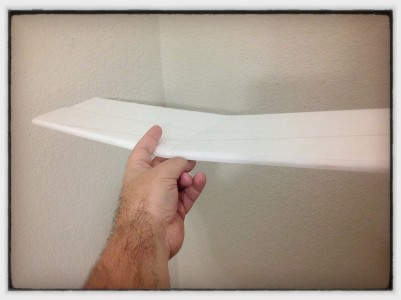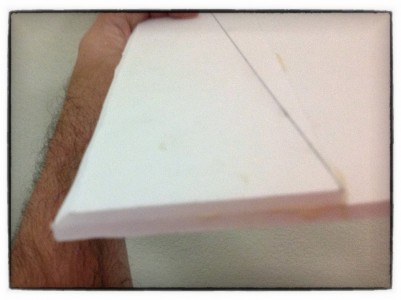As I was watching Vogelsong pitch a gem against the Cardinals, I thought it might be cool to try some additional experiments with paper/foamcraft and try to create a simple (even trivial) wing from some Dollar Tree foamboard.
I had previously experimented with building an Armin wing as described by Ed at Experimental Airlines. It generates a nifty wing, with a true airfoil shape. But it’s kind of complicated, and I wanted to see how simple I could make a wing using Dollar Tree foamboard. I had very modest goals: just something that might provide a little better lift than a flate plate. I decided to try fabricating a 30″ wing with a 6″ chord, in the style of a Kline-Fogelman airfoil, in particular the KFm-2 design, which has a step at 50%.
Fabrication couldn’t be simpler: I just cut two pieces from foamboard, one 6″x30″, another just 3″x30″. I could have just hot glued them together, but I decided to be a bit more refined. I stripped the paper off one side of the 3″x30″ piece, and scored and stripped a section the same size off the 6″ piece, so that I would be gluing foam to foam. I then spread a fairly reasonable amount of Gorilla glue to one side, and wiped the other with a dampened paper towel (the water is supposed to enhance foaming, making the glue spread out). I then placed them together, and put my 2″ wide steel ruler over it, and clamped it down to my workspace to set. The hardest thing is waiting for glue to dry, but after an hour, I could see that the foaming had caused a tiny amount of the glue to eek out of the side. I unclamped it briefly to check it out: it seemed very much stiffer than the single layer, and might not even need additional stiffening to use it in a small, lightweight trainer. When it’s completely set, I’ll cut a bevel onto the front, which should give it a tiny bit of aerodynamic efficiency and then cover the leading edge with some packing tape.
The specifications on the Wiki page say that a KFm-2 wing should have a thickness which is 7%-9% of the wing chord, which means a thickness of about .4″ to .54, this wing turns out to have a thickness of about 3/8 of an inch, which is a tiny bit thin, but I’m going with it anyway. For a novice trainer, some dihedral angle would be useful as well, so I think I’ll score the middle and fill it with hot glue. I could add some ailerons, but I think maybe just elevator and rudder controls would make sense, so that would probably be it for the wing.
Not sure what I’ll do for the body yet. But my goal is simple, simple, cheap and simple.
Pictures later.
Addendum: Okay, here are some pictures.
I didn’t do an amazing job: it’s just an experiment after all. I cut a rough 45 degree angle through the top layer of the wing, and then beveled it with a dry wall sanding block. The results are pretty reasonable. I scored through the bottom of the wing, and cracked it, filled it with glue, and held it in place at the dihedral angle (just the height of a book I had on hand) until it set, and I then covered the joint with packing tape. Overall, I’m pretty happy with the result of the experiment. I think it’s usable.

